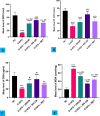Camel milk ameliorates diabetes in pigs by preventing oxidative stress, inflammation and enhancing beta cell function
- PMID: 36404858
- PMCID: PMC9672245
- DOI: 10.1007/s40200-022-01112-1
Camel milk ameliorates diabetes in pigs by preventing oxidative stress, inflammation and enhancing beta cell function
Abstract
Purpose: The purpose of the study was to determine how camel milk affects hyperglycemia, beta-cell function, oxidative stress, and inflammatory markers in type 2 diabetic pigs.
Methods: Twenty-five (25) pigs were separated into five (5) groups of five pigs each, with five (5) non-diabetic and twenty (20) diabetic pigs in each group. Groups 1 and 2 received distilled water as the standard control and diabetic control groups, respectively, while Groups 3 and 4 received camel milk at 250 mL/day and 500 mL/day, respectively, and Group 5 received metformin at 500 mg/day. The experiment lasted ten weeks. At the end of the ten weeks, all the pigs were euthanized.
Results: Treatments with camel milk substantially enhance glucose fasting levels by reducing hyperglycemia in diabetic pigs, significant level at (p < 0.05). When pigs given camel milk were compared with untreated diabetic pigs, there was a substantial rise (p < 0.05) in superoxide dismutase (SOD), catalase (CAT), and reduced glutathione (GSH) levels. Also, camel milk substantially lowered the levels of interleukin (IL-1β) and tumour necrosis factor-alpha (TNF-α) in diabetic pig serum. Similarly, immunohistochemical analysis of islet cells revealed an increase in insulin production, implying improved glycemic control and the eventual commitment of glucose to glycolysis.
Conclusion: The bioactive-mediated anti-hyperglycemic and insulin release potential of camel milk treatments contributed to improving type 2 diabetes mellitus. Camel milk improved beta-cell function while reducing oxidative stress and inflammation in type 2 diabetic pigs.
Keywords: Camel milk; Hyperglycemia; Inflammatory markers; Oxidative stress; Pancreas.
© The Author(s), under exclusive licence to Tehran University of Medical Sciences 2022, Springer Nature or its licensor holds exclusive rights to this article under a publishing agreement with the author(s) or other rightsholder(s); author self-archiving of the accepted manuscript version of this article is solely governed by the terms of such publishing agreement and applicable law.
Conflict of interest statement
Competing interestsThe authors declare there are no competing interests.
Figures






Similar articles
-
Camel milk ameliorates hyperglycaemia and oxidative damage in type-1 diabetic experimental rats.J Dairy Res. 2016 Aug;83(3):412-9. doi: 10.1017/S002202991600042X. J Dairy Res. 2016. PMID: 27600979
-
Camel milk attenuates the biochemical and morphological features of diabetic nephropathy: inhibition of Smad1 and collagen type IV synthesis.Chem Biol Interact. 2015 Mar 5;229:100-8. doi: 10.1016/j.cbi.2015.01.013. Epub 2015 Jan 21. Chem Biol Interact. 2015. PMID: 25617480
-
Effect of camel milk protein hydrolysates against hyperglycemia, hyperlipidemia, and associated oxidative stress in streptozotocin (STZ)-induced diabetic rats.J Dairy Sci. 2021 Feb;104(2):1304-1317. doi: 10.3168/jds.2020-19412. Epub 2020 Nov 30. J Dairy Sci. 2021. PMID: 33272578
-
Camel milk: a possible boon for type 1 diabetic patients.Cell Mol Biol (Noisy-le-grand). 2013 Nov 3;59(1):99-107. Cell Mol Biol (Noisy-le-grand). 2013. PMID: 24200025 Review.
-
The molecular basis of the anti-diabetic properties of camel milk.Diabetes Res Clin Pract. 2018 Dec;146:305-312. doi: 10.1016/j.diabres.2018.11.006. Epub 2018 Nov 16. Diabetes Res Clin Pract. 2018. PMID: 30452940 Review.
Cited by
-
Non-Bovine Milk as Functional Foods with Focus on Their Antioxidant and Anti-Inflammatory Bioactivities.Antioxidants (Basel). 2025 Jun 27;14(7):801. doi: 10.3390/antiox14070801. Antioxidants (Basel). 2025. PMID: 40722905 Free PMC article. Review.
References
-
- Miranda-Osorio PH, Castell-Rodríguez AE, Vargas-Mancilla J, Tovilla-Zárate CA, Ble-Castillo JL, Aguilar-Domínguez DE, Juárez-Rojop IE, Díaz-Zagoya JC. Protective Action of Carica papaya on β-Cells in Streptozotocin-Induced Diabetic Rats. Int J Environ Res Public Health. 2016;13:446. doi: 10.3390/ijerph13050446. - DOI - PMC - PubMed
-
- Williams R, Karuranga S, Malanda B, Saeedi P, Basit A, Besançon S, Bommer C, Esteghamati A, Ogurtsova K, Zhang P, Colagiuri S. Global and regional estimates and projections of diabetesrelated health expenditure: results from the International Diabetes Federation Diabetes Atlas, 9th edition. Diabetes Res Clin Pract.2020; 162: 108072. 10.1016/j.diabres.2020.108072. - PubMed
LinkOut - more resources
Full Text Sources
Miscellaneous

